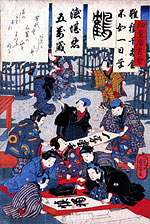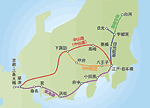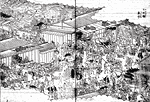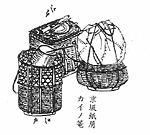|
|
|
|
|
||||||||||
HOME > the spirit of the brabd nihonbashi-bijin > Sou:Edo Nihonbashi Skillfully Expressed by Ukiyoe Artists
Artists with special skills created new traditions by absorbing the trends of their times.
Why don't you gain the beauty of Edo people by studying the history of creation that underlies the spirit of the Nihonbashi-bijin brand?
Why don't you gain the beauty of Edo people by studying the history of creation that underlies the spirit of the Nihonbashi-bijin brand?
A town built upon wisdom

 Private educational schools for the public, known as terakoya answered to the need for education during the Edo era. The origins of terakoya schools can be traced back to the late Muromachi era, and it apparently grew out of the system for educating acolytes in Buddhist temples. Classes were primarily conducted by Buddhist priests in temples since the middle of the Edo era. Eventually, however, people from other walks of life, such as samurai, doctors, Shinto priests, and town officials also began teaching to the general public, and the system spread rapidly. Education was individualized, and teachers provided learning models for children as they grew.
Private educational schools for the public, known as terakoya answered to the need for education during the Edo era. The origins of terakoya schools can be traced back to the late Muromachi era, and it apparently grew out of the system for educating acolytes in Buddhist temples. Classes were primarily conducted by Buddhist priests in temples since the middle of the Edo era. Eventually, however, people from other walks of life, such as samurai, doctors, Shinto priests, and town officials also began teaching to the general public, and the system spread rapidly. Education was individualized, and teachers provided learning models for children as they grew.In order to open the way for cultured women to work in the service of samurai families, terakoya girls' schools taught discipline and etiquette to girls from a very young age.
In addition to reading, writing, and calculating with an abacus, terakoya schools were a place where people learned how to create documents, write letters, and gain knowledge important for everyday living.
Reference: Hidekazu Ishiyama, Terakoya De No Kyoiku (Education in Terakoya Schools), from Edo Jidaikan (Shogakukan).
Documents provided by: Kumon Kyoiku Kenkyukai (Utagawa Kuniyoshi, “Yodo Sekishokai” (Children's New Year calligraphy event))

 Tanaka Kyugu, who served in such capacities as administrative head of the Kawasaki post town on the Tokaido Highway during the mid-Edo era, presented an opinion in an administrative document to the shogunate in which he expressed the necessity for a road system. He stated, “A road system is as important to the country as arteries running through the body, and they run nonstop. I ask if there could be any better means for governing a nation. Roads are the most important facility the state could provide for developing commerce for the people.” It is surprising that a Tokugawa-shogunate-era document, such as this, exists in which the significance of roads is so accurately expressed.
Tanaka Kyugu, who served in such capacities as administrative head of the Kawasaki post town on the Tokaido Highway during the mid-Edo era, presented an opinion in an administrative document to the shogunate in which he expressed the necessity for a road system. He stated, “A road system is as important to the country as arteries running through the body, and they run nonstop. I ask if there could be any better means for governing a nation. Roads are the most important facility the state could provide for developing commerce for the people.” It is surprising that a Tokugawa-shogunate-era document, such as this, exists in which the significance of roads is so accurately expressed.There was a road network in the Edo era comprising the Tokaido, Nakasendo, Nikko Kaido, Oshu Kaido and Koshu Kaido highways, and their constituent roads, which were all under the shogunate's direct control, and sub-roads relegated to the control of local feudal lords. The Tokaido Highway, jointing Edo and Kyoto, was the most important road in the network, and 53 post towns were erected along it, each stationed with one hundred men and horses.
This kind of highway-based town development began in the Edo era. And the present-day system of roads derives from the Gokaido, for which Nihonbashi was the point of origin.
Reference: Kenichi Takebe, Michi No Hanashi (About Roads), (Gihodo Shuppan), 1992.

 Nihonbashi Uogashi was an area on the north bank of the Nihonbashi River between the Nihonbashi and Edobashi bridges, and was centered on the Honfunacho, Honodawaracho, Nagahamacho, and Anjincho districts.
Nihonbashi Uogashi was an area on the north bank of the Nihonbashi River between the Nihonbashi and Edobashi bridges, and was centered on the Honfunacho, Honodawaracho, Nagahamacho, and Anjincho districts.When Tokugawa Ieyasu entered Edo in 1590 in the wake of the Honnoji No Hen (Incident at Honnoji Temple), during which some fishermen came to his aid, Mori Magoemon, the administrative leader of Tsukuda Village in Saijo, Sesshu (now Tsukudacho in Yodogawa-ku, Osaka) also moved there bringing about 30 fishermen with him. He was ordered by the shogunate to provide them with fresh fish, and he sold the rest in Honfunacho to the public. This is said to be how Nihonbashi Uogashi got its start.
In more recent years, Nihonbashi grew to be a bustling Tokyo urban center, and the topic of relocating Uogashi arose because the riverfront was small and fish were being increasingly transported by train. When Uogashi was destroyed by fire in the Great Kanto Earthquake of 1923, it was moved to the Tsukiji district.
The present Tsukiji Market is a very prosperous and bustling place. However, it is lacking in space, and the Tokyo government is planning to move it to the Toyosu district by 2012.
Reference: Tokyo-to No Chimei (Tokyo Place Names), no. 13 in the Nihon Rekishi Chimei Taikei series, (Heibonsha).
Hasegawa Settan, “Nihonbashi fish market,” from Edo Meisho Zukai. National Diet Library.


 Recycling was a major part of society during the Edo era. People regularly used things to the fullest extent possible in their daily lives.
Recycling was a major part of society during the Edo era. People regularly used things to the fullest extent possible in their daily lives.One example of recycling resources is the reuse of paper. Almost all paper was purchased by various types of paper recyclers and reused. There were many paper makers located around the Asakusasanya area near the Yoshiwara district in Edo, and Asakusa paper was a popular item.
Tanned paper was also produced by pasting three or four sheets of old paper together and applying persimmon juice. It was put to use for such things as sunshades, mats, and packaging material because it resisted humidity and repelled insects.
With consumption on the rise in modern society, there are many things to be learned from the system of recycling that existed in the Edo era.
Reference: Manabu Oishi, Recycle No Shikumi (Methods of Recycling), from Edo Jidaikan, (Shogakukan).
(up)Enkoan, “Secondhand clothing seller,” from Edo Junranki. The Toyo Bunko.
(down)Morisada Manko, “Paper scrap buyer.” National Diet Library.
Production cooperation from: CTI Engineering Co., Ltd.; Research Center For Sustainable Communities
|



